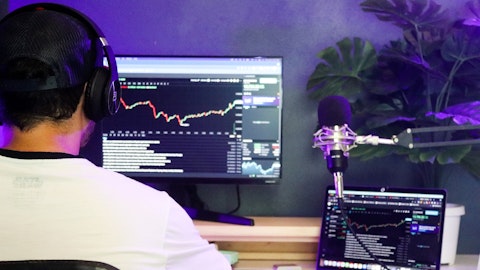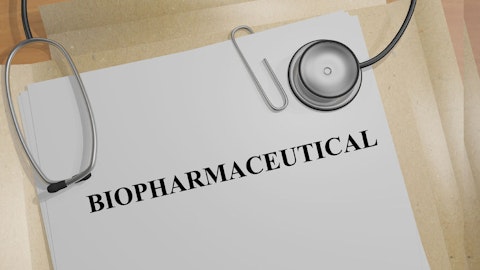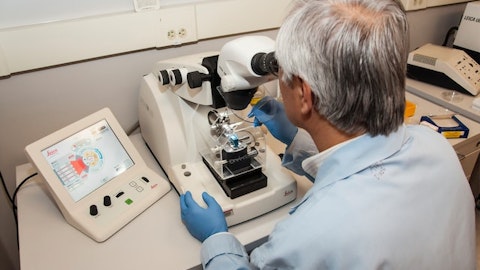Arbutus Biopharma Corporation (NASDAQ:ABUS) Q3 2023 Earnings Call Transcript November 7, 2023
Arbutus Biopharma Corporation reports earnings inline with expectations. Reported EPS is $-0.12 EPS, expectations were $-0.12.
Operator: Good day, and thank you for standing by. Welcome to the Arbutus Third Quarter Corporate and Financial Update Conference Call. [Operator Instructions] Please be advised that today’s conference is being recorded. I would now like to hand the conference over to Lisa Caperelli. Please go ahead.
Lisa Caperelli: Thank you, Brianna. Good morning, everyone, and thank you for joining Arbutus’ third quarter 2023 financial results and corporate update call. Joining me today from the Arbutus executive team are Bill Collier, President and Chief Executive Officer; David Hastings, Chief Financial Officer; Michael J. McElhaugh, Chief Operating Officer Dr. Mike Sofia, Chief Scientific Officer; and Dr. Karen Sims, Chief Medical Officer. Bill will begin with a corporate update, followed by Dave Hastings who will provide a review of the company’s third quarter 2023 financial results. After our prepared remarks, we will open the call for Q&A. Before we begin, I’d like to remind you that some of the statements made during the call today are forward-looking statements, which are subject to a number of risks and uncertainties that may cause our actual results to differ materially, including those described in our most recent annual report on Form 10-K, our quarterly report on Form 10-Q, which will be filed later today and from time to time in our other documents filed with the SEC.
With that, I’ll turn the call over to Bill Collier. Bill?
Bill Collier: Good morning everyone and thank you very much for joining us today. As you likely saw in addition to reporting our third quarter results earlier this morning, we also announced that I will be retiring at the end of the year. I’ll speak more about that shortly, but first let’s discuss our results. At Arbutus, we remain committed to our goal of developing a functional cure for patients with chronic hepatitis B virus by advancing the development of our clinical assets that can be combined to create a curative treatment regimen. Over the last few months, we’ve optimized our pipeline, including the discontinuation of our coronavirus research programs and our oral RNA destabilizer. This allows us to sharpen our focus and resources on our most promising clinical programs, imdusiran and AB-101, both of which are expected to have data readouts next year.
As a result of this pipeline prioritization, we are also announcing today the difficult decision to streamline our organization by reducing our workforce by 24%. We want to underscore how grateful we are to all of our employees, especially those departing the organization for their dedication and passion in developing novel therapeutics for viral diseases at Arbutus. And while these changes primarily impact our research function, we have maintained a group of research scientists as we remain committed to continuing discovery research in chronic HBV. Now we know that changes that impact our people are not easy, and we’re committed to providing those employees with support as they transition to their next roles. At the same time, we’re confident that Arbutus remains positively positioned for the future.
Now I’d like to provide some updates on the continued progress that we’re making across our pipeline. With more than 290 million people worldwide chronically infected with HBV, and with current lifelong treatment options resulting in less than a 5% cure rate, there remains a large unmet medical need for a functional cure for chronic HBV. We believe we’re well suited to address this need with our team’s extensive expertise in virology and with imdusiran, which is one of the most advanced RNAi therapeutics in development. Based on data generated to date, imdusiran has shown to impact all three components needed for a functional cure for patients with chronic HBV. Those are reducing HBV DNA, suppressing surface antigen, and reawakening the HBV-specific immune response.
Our strategy to develop a functional cure for HBV involves exploring imdusiran in combination with other investigational and approved products that can further stimulate the immune system to induce functional cure in chronic HBV patients. Imdusiran is our lead asset, and later this week at a prestigious liver-focused medical conference, AASLD’s The Liver Meeting, we will be presenting a late-breaking poster with preliminary data from our Phase 2a clinical trial that we’re conducting with Barinthus Bio-therapeutics, formerly known as Vaccitech. Through this clinical trial, we’re testing whether the combination of imdusiran, new therapy, and Barinthus’ HBV antigen-specific immunotherapeutic VTP-300 can lower surface antigen and stimulate the host immune system to fully suppress the virus.
As I’ve mentioned previously, this is an early look at data, as not all patients have received the full VTP-300 or placebo dosing regimen. In addition to safety data, from an efficacy standpoint, we’re hoping to see a reduction in surface antigen within 24 weeks of, sorry, we’re hoping to see a reduction in surface antigen with 24 weeks of imdusiran treatment that is similar to what we’ve seen in our other clinical trials to date, and further impact on HBSIG and HBV-specific immune activation with the addition of VTP-300. We look forward to reporting these data at AASLD. Now you may recall that we’ve expanded this trial to explore the addition of a low dose of the anti-PD-1 monoclonal antibody inhibitor, nivolumab, to the combination treatment regimen.

We believe nivo may further boost the host immune response. The data that we’re reporting at AASLD will not include any data from this expanded arm, as we’re in the early stages of this trial. We will have more to report on this portion of the clinical trial next year. We also have a second Phase 2a clinical trial that is evaluating imdusiran in combination with ongoing nuke therapy and interferon in patients with chronic HBV. Earlier this year, we reported preliminary data that continues to reinforce our confidence in imdusiran’s ability to effectively lower surface antigen. We’re continuing to follow these patients and expect to provide updates from this clinical trial in 2024. Our second HBV asset is AB-101, our oral PD-L1 inhibitor that is currently in a Phase 1a, 1b clinical trial.
Immune checkpoints have been shown to play an important role in HBV-specific immune tolerance and in T-cell activation. This double-blind, randomized, placebo-controlled clinical trial is designed to investigate the safety, tolerability, pharmacokinetics, and pharmacodynamics of AB-101. The trial will be conducted in three parts, starting with single and multiple ascending doses in healthy subjects, and culminating with multiple doses in patients with chronic HBV. In September, we announced that we dosed the first patient in the single ascending dose group of the trial and expect initial data from that group in the first half of 2024. Finally, let me spend a moment talking about my decision to retire as CEO at the end of this year. As many of you know, I’ve had the privilege to lead Arbutus since June 2019, and since then we’ve accomplished so much.
This was a particularly challenging decision for me to make personally, and one that is completely unrelated to recent activities at Arbutus. I remain confident in imdusiran and AB-101 and the ability of this team to develop these compounds to possibly provide a functional cure for patients with chronic HBV. My four-year plus tenure at Arbutus is one of the most rewarding positions I’ve had in my career. The opportunity to lead a group of talented and passionate researchers, clinicians, and professionals with a drive to serve the HBV patient community has been a true privilege. We’ve achieved many successes and key milestones, and as I look to my future retirement, I’m confident in the future of Arbutus. Now, Mike McElhaugh will succeed me as interim CEO effective January the 1st.
As many of you know, Mike is a co-founder of Arbutus and serves as our Chief Operating Officer. He has more than 20 years of scientific, strategic, transactional, and commercial experience spanning various operating roles within Bristol-Myers Squibb, Pharmasset [Ph], Merck, and Viropharma. The board and I have the utmost confidence in Mike’s ability to be successful in leading Arbutus and to continue to create value for our shareholders. Mike has worked very closely with me over the last four plus years, and I’m confident that there will be a smooth transition. And I will also continue to be a resource for Mike as he becomes acclimated to his new role. In closing, I’m confident in Mike’s leadership as he leads Arbutus into its next chapter.
Imdusiran and AB-101 are well-positioned to deliver on our goal of developing a functional cure for HBV and driving value for our company as we advance these HBV assets. With that, I’ll hand the call over to Dave Hastings for a brief financial update.
David Hastings: Thanks, Bill, and good morning, everybody. We ended the third quarter of 2023 with approximately $145 million of cash, cash equivalents of investments, compared to approximately $184 million as of December 31st, 2022. During the nine months ended September 30th, 2023, we received approximately $26 million of net proceeds from the issuance of common shares under Arbutus’ at-the-market offering program. These cash inflows were offset by approximately $69 million of cash used in operations. As Bill mentioned, today we announced that we reduced our workforce by 24%. Importantly, we have maintained a discovery research capability in HBV and continue to believe we have the people necessary to advance our clinical-stage HBV pipeline.
With this reduction in workforce, we will incur a one-time restructuring charge of approximately $1.1 million that will be recorded in the fourth quarter of 2023. We expect our 2023 net cash burn to range between $90 million to $95 million, excluding any proceeds received from our at-the-market offering program. Importantly, we believe our cash runway will be sufficient to now fund our operations into the first quarter of 2026. In closing, we have a strong financial position to advance our mission, and we remain committed to developing our HBV assets to provide a functional cure for chronic HBV. With that, I will now turn the call back to Bill.
Bill Collier: Thanks, Dave. As I mentioned earlier, we’re looking forward to reporting preliminary data from the AB-729-202 Phase 2a study combining imdusiran, NUC therapy and VTP-300 at the AASLD liver meeting in the coming weeks. Immediately following that medical congress, we’ll be attending the Jeffries Healthcare Conference in London. So please reach out to Lisa if you want to schedule time to meet with the team to review that data. In closing, I wish the best to our departing employees, and again, thank them for their dedication and many contributions to the company as we continue to pursue our goal of developing a functional cure for patients with chronic HBV. Operator, we’re now ready to open the call for any Q&As.
See also 15 States That Don’t Tax Social Security Or Pensions and 12 Gene Editing Stocks With the Best Long-Term Potential.
Q&A Session
Follow Arbutus Biopharma Corp (NASDAQ:ABUS)
Follow Arbutus Biopharma Corp (NASDAQ:ABUS)
Operator: Thank you. At this time, we will conduct the question-and-answer session. [Operator Instructions] Our first question comes from Roy Buchanan for JMP. Your line is now open.
Roy Buchanan: Hi. Great. So congrats to Bill for the retirement just as things are getting exciting over there and congrats to Mike for the promotion. I guess maybe if you will start with AB-101, just the results in the first half of next year. Are you going to have, sounds like maybe not, but the complete SAD results and maybe just give us some patient number details if you can. And then are you going to share the data regularly with the FDA or are you going to wait to complete the whole Phase 1? And then just remind us what other activities like preclinical studies are underway with 101.
Bill Collier: Okay, Roy. Thank you. Thank you for your well wishes. I’ll turn it over to Karen in a moment. Maybe the best thing we could do to answer your question is just to describe the structure of the 101 Phase 1a study. I think I misspoke earlier on when I said it was a double-blind randomized study. So Karen, perhaps you could clarify that and answer Roy’s question.
Karen Sims: Absolutely. So I should know, Bill, you were correct. It is a double-blind randomized clinical trial. So it is a, what we call an umbrella trial. So there are healthy subject portions of the trial and chronic hepatitis B patient portions of the trial. So we begin in single ascending dose and healthy subjects and then move to multiple dose and healthy subjects and then on to chronic hepatitis B patients. So the way these trials run, you obviously need data from each part of the trial to advance to the next part of the trial. So right now, as Bill said, we’re in the single ascending dose portion of the trial. We do expect to have data next year. It really depends on the cadence of the trial. If things continue to move smoothly, we recruit our subjects in a timely manner.
So we should have some safety data, some PK data, some preliminary pharmacodynamic data in the first half of the year for the single dose portion of the trial in healthy subjects. Beyond that, it really just depends again on the cadence of the trial, the recruitment, and we will disclose data once we have a meaningful data package to report.
Roy Buchanan: Okay, great. And then maybe what other activities are you doing? Some preclinical studies or anything that’s underway with this one-on-one?
Bill Collier: Mike, do you want to take that one?
Michael Sofia: Well, the standard non-clinical safety studies continue to move forward with 101. I think we’ve established a pretty solid package of data, preclinical data that supports the mechanism, which is novel, which supports efficacy in animal models. And obviously, ideal PK profile, which is liver targeting for this agent. But really, right now, the only activities is all the non-clinical toxicology assessments that are required to support further progression of the drug.
Roy Buchanan: Okay, great. One more detailed question. Just in the inducer end studies, how frequently do you check for seroconversion of S antigen? And then on that really crystal ball or speculative question, have you guys ever considered hepatitis delta? Some of your competitors are using the same agents for hepatitis B and potential hepatitis delta. Have you considered that indication? And just what are your thoughts around that? Thanks.
Bill Collier: So Karen, do you want to take the first part and then Mike the second?
Karen Sims: Absolutely. So we are checking frequently in all of our clinical trials for surface antigen loss and seroconversion. The timing really depends on how the clinic visits were set up for subjects. So typically, whenever there’s a clinic visit for a subject, we do collect those parameters just for monitoring. So it can vary anywhere from every month to every eight weeks, depending on where the subject is in the clinical trial, whether they’re in the dosing phase and the follow-up phase. So we do collect those parameters at pretty much every study visit. And I would say ballpark every month, if not more frequent.




